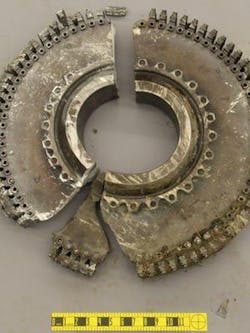At a Glance:
- Johns Hopkins University researchers detail a new method for testing metals at a microscopic scale.
- The research exposes the origins of crack initiation in metals and unravels a method to prevent catastrophic events.
- Jaafar El-Awady makes a case for selecting materials that reduce the probability of fatigue cracking in metallic components used in airplanes, bridges and other structures that crack.
Defect and failure inspections on aircraft components play an important role in aircraft safety. All the better for preventing potentially devastating mechanical failure aboard the aircraft, argues Jaafar El-Awady, a Johns Hopkins University researcher looking at the many ways that failure mitigation can be extended in the selection of metallic components and the quality of materials used.
Academic and applied work in understanding the origins of crack initiation has largely been centered on the moment just before or after the cracking to assess what happened in the makeup of the metal, said El-Awady, who is the founder and director of the Johns Hopkins Computational and Experimental Materials Engineering Laboratory (CEMEL).
Until now, these observations have provided limited information on selecting materials that reduce the probability of fatigue cracking of components. “While we know that this happens, we don’t always know why it happens,” said El-Awady, whose research focus is primarily in the field of mechanics of materials for extreme environments.
He explained that design engineers know that fatigue in the metal is linked to the number of loading cycles. On an aircraft, for instance, where there’s pressurizing or depressurizing and rotating components in the engine, metals tend to fail after a certain number of cycles. “One of the biggest issues has been trying to predict when that would happen,” he said. “It’s typically quite difficult—almost impossible—to predict or pinpoint that one component is actually going to fail.”
But El-Awady’s latest research, published in Science, focuses on testing metals at sub-micrometer scale and provides a new method for determining what leads to cracks. “Fatigue failure plagues all metals,” he explained. “It is the leading cause of cracks in metallic components of aircraft.”
Research Technique and Interest
Since fractures happen at a nanoscale, researchers cannot typically observe the fracture process in small-scale experiments or by looking at cracks with the naked eye. In these instances, the crack is observed only after it was initiated. Using a scanning electron microscope, El-Awady’s new experimental technique is able to observe materials at sub-micrometer scale, allowing researchers to observe the entire sample surface.
“In addition, we’re able to observe the damage as it evolves, as the crack nucleates, as well as observe the crack initiation processes as they happen on the surface,” he elaborated. The experiments enable researchers to infer the mechanisms driving the nucleation of the cracks and how the localization of damage actually happens in the material.
Understanding the quality of material has other benefits, too: There is significant amount of interest in predicting failure. “If you can predict when a sample is going to fail, then you don't really have to throw it away,” El-Awady explained. “In many instances, if you're saying that a sample has a point 1% probability of failure, there’s 99.9% chance that the sample is not going to fail. So, if you’re throwing it away, that piece of material could actually be absolutely fine—you just don’t know—and that’s potentially a significant waste of money.”
The Johns Hopkins research interest was in trying to enrich the fundamental understanding of how cracks initiate, which is the initiation stage of a fatigue fracture. El-Awady defines “fracture” as the state where the entire sample has reached a catastrophic failure event. “After cracks initiate, they eventually propagate and you get the full failure,” he said. “The tricky part is, depending on the type of loading cycles, a component can spend 90% of its life in the stages of initiation of a crack, or it can be 10%, depending on the loading history.
What is not well understood in literature is how cracks initiate in materials,” he continued. “What is known is that if there’s a large enough crack that we can observe, we can predict when the sample is going to fail, given loading conditions and given the pre-existence of a crack.”
This background helped characterize the research problem, since crack initiation typically happens at the nanoscale and metals have signatures. El-Awady further explained that metals deform through dislocations. These are Venier defects in the atomic arrangement of the crystal structure of metals. That localization of damage, it has been argued, is the precursor to crack initiation. Yet, El-Awady believes the localization of those defects has not been well understood.
The researchers used pure nickel in their experiments because it is the base material typically used in turbine engines; these are fabricated with nickel-based superalloys. The rationale for using a pure metal was to avoid influences that could muddy the understanding of the fatigue. The mechanisms that lead to localization and crack initiation are more or less the same in all different types of metals, El-Awady said.
Not All Cracks Lead to Failure
He maintains there’s a lot more that can be quantified based on the current research. One observation in this experiment is there is a significant number of small cracks that nucleate. Another is that not all of the cracks are going to propagate and lead to complete failure.
“Eventually, a very small set of these cracks are going to dominate and then they’re going to propagate and fail,” said El-Awady. “One of the biggest questions now is, what are the main characteristics that drive a particular short crack into propagating into a crack that will lead to catastrophic failure? This is something known in literature as statistics of short crack propagation, which provides estimates of fatigue strengths.”
In general, researchers want to understand the size of the crack and gauge the material’s strength relative to the dimensions of the component and the intrinsic dimensions, or microstructure, of the material itself. However, the research community has significant trouble in quantifying which short crack will eventually lead to a fracture, noted El-Awady.
“If you can quantify that, then you’re pretty much done with the process of fracture from the initiation of the short cracks, to defining and figuring out which cracks are going to dominate and lead to large cracks,” he said. “And then we understand how large cracks will behave afterwards. This is the missing link and is of significant interest for the community in predicting fatigue damage, fracture and failure.”
Practical Implications
Knowing how cracks occur will enrich the opportunity to model it, estimated El-Awady. “And if you’re able to model it, then you can predict it. And if you can predict it, then you can basically design the material in a way that improves the material performance or the component life and so forth.
In the design process, the industry designs for fatigue failure by relying on S-N (strength versus number of cycles to failure) curves, he explained. This is an empirical-based approach with very little understanding of the deformation in a particular material. The curves help predict when a component should be replaced.
With a new fundamental understanding, El-Awady’s team hopes the research will drive a much more rigorous approach for predicting fatigue damage. As a practical example, he points to a technique that’s already in use: crystal plasticity finite element modeling, which predicts the illusion of damage. In this technique the researcher feeds knowledge about the microstructure and features of the material into the simulation and tries to predict how the material evolves.
These types of simulations require physical understanding of the mechanisms and how they evolve, El-Awady noted. The results of his new method would feed into those types of simulations, enriching their physics-based modeling capability in a way that they can predict failure for a specific microstructure of a material, as well as design the material differently.
About the Author

Rehana Begg
Editor-in-Chief, Machine Design
As Machine Design’s content lead, Rehana Begg is tasked with elevating the voice of the design and multi-disciplinary engineer in the face of digital transformation and engineering innovation. Begg has more than 24 years of editorial experience and has spent the past decade in the trenches of industrial manufacturing, focusing on new technologies, manufacturing innovation and business. Her B2B career has taken her from corporate boardrooms to plant floors and underground mining stopes, covering everything from automation & IIoT, robotics, mechanical design and additive manufacturing to plant operations, maintenance, reliability and continuous improvement. Begg holds an MBA, a Master of Journalism degree, and a BA (Hons.) in Political Science. She is committed to lifelong learning and feeds her passion for innovation in publishing, transparent science and clear communication by attending relevant conferences and seminars/workshops.
Follow Rehana Begg via the following social media handles:
X: @rehanabegg
LinkedIn: @rehanabegg and @MachineDesign

